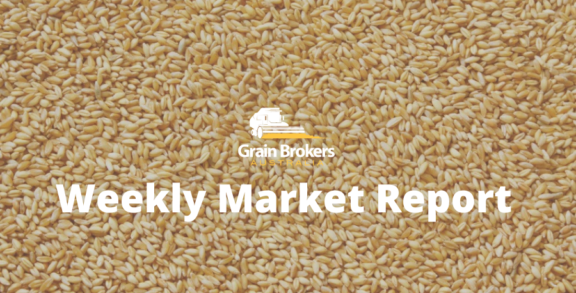
Grain Brokers Australia Weekly Market Report
13th November, 2018
Lest we forget…
Outside of the US midterm elections, two events stole the spotlight in global grains markets over the past week. Firstly, the results of the most recent Saudi Arabian barley tender, and secondly, the World Agricultural Supply and Demand Estimates (WADSE) released by the United States Department of Agriculture (USDA).
Early last week the Saudi Arabian Grains Organisation (SAGO) announced that it had purchased 1.02 million metric tonnes of barley for January and February delivery. The average price was US$266.83 per metric tonne cost and freight (CFR), with all but one cargo going to Glencore. This was up just over US$6 on the previous tender but was still viewed as aggressive by the EU trade with values US$8-10 lower than most expectations.
SAGO reported that offers were received from most of the major origins including European Union (EU), North America (excluding Canada), South America, Australia and a number of Black Sea states. The only exporter not in the game at the moment is Australia. Assuming a freight of US$26 to Jeddah then that puts Aussie replacement around US$20 out of the money. The Black Sea and EU offers are pretty close into Jeddah, but the cheapest origin appears to be Argentina.
Interestingly, the spread between Jeddah and Arabian Gulf delivery has narrowed to just US$3 suggesting that a significant share of the execution will be from Argentina. Open export licenses for Argentine barley for the 2018/19 season currently stand at 1.13 MMT. This is around half of the estimated exportable surplus, but it will not all go out in this tender.
The majority of the barley production area is in the south of the country, so harvest is not expected to commence until late November, weather permitting, with the peak harvest period being December. Whilst December shipment will be possible, it is more likely that Russia, Ukraine and possibly EU origins will fill the early Saudi delivery periods with Argentina chiming in for six to eight of the late January and February 60,000 metric tonne slots.
Saudi Arabia is expected to import around 8.5MMT of feed barley in the current marketing year. In the 2017/18 season, Russia overtook Ukraine as the largest supplier of feed barley to the Kingdom. They supplied 29 per cent and 23 per cent respectively, with Germany (13 per cent) and Romania (10 per cent) rounding out the top four. That means that almost two-thirds of their requirements came from the Black Sea region.
The highlight of last week’s WADSE report were the dramatic changes to corn stocks in China. A day before the report was released the China National Grain & Oils Information Centre (CNGOIC) revised the countries corn production data for the previous decade. The overhaul was a result of last year’s agricultural census, the first in China for ten years. It highlights the amount of land in the northeast of China that has been bought into agricultural production in recent years and was not previously registered with the government for such purposes.
CNGOIC added a whopping 294MMT to their corn production numbers over the decade, more than 170MMT of that in the past four seasons. Last season’s production was adjusted from the previously reported 215.9MMT to 259MMT, an increase of 20 per cent. This was bought about by an increase in planted area from 35.5 million hectares to 42.4 million hectares.
There was obviously some frantic activity in the USDA building after the China update was released. In the end, they adopted the revised China production numbers (for now). The USDA increased China’s 2018/19 ending stocks by 149MMT to 207.5MMT. And this is after China has auctioned more than 100MMT for their strategic corn reserves this year. As a consequence, world ending stocks increased by 148.16MMT to 307.51MMT. That is almost double the October estimate. How does that happen? Only in China, I guess!
Obviously, domestic consumption in China has also been underestimated, or so the USDA believes, as the increase in ending stocks only account for about half of the aforementioned production adjustment since 2009. However, from a global trade viewpoint, the true indicator of world ending stocks is the one that excludes China and that remained relatively unchanged at 100MMT. That is despite the larger than expected decrease in estimated United States (US) corn yields from 180.8 bushels per acre (11.34 metric tonne per hectare) to 178.9 bushels per acre (11.22 metric tonne per hectare).
The USDA also revised China’s wheat production estimates following the data adjustment from the government. The 2018/19 projections were raised 4.5MMT to 132.5MMT and ending stocks for the same season were forecast to be 143.6 MMT, 7.5MMT higher due to increased supplies in prior years.
WADSE decreased the Australia wheat crop forecast by 1MMT to 17.5MMT. The export number was reduced by 1.5MMT to 11.5MMT. No surprise to see that both these numbers are still well above local consensus. They fudged the books a little by increasing 2018/19 carry in stocks to 5.7MMT so that the carryout number could remain stable at around 3MMT.
I would like to finish this week’s report by forgetting grain markets for a moment. Last Sunday was Remembrance Day, exactly one hundred years since the guns fell silent over Europe, marking an end to the First World War. To that point in time, it was the bloodiest and deadliest war the world had ever seen. It was coined “the war to end all wars”. Unfortunately, we now know that not to be true.
In 1914 the Australian population was less than five million. Almost 420,000 Australian’s enlisted for service. That was almost 10 per cent of the population. Many of us have forefathers who fought at Gallipoli, in Europe or the Middle East. Freedom is not a privilege, it is earnt, and too many Australians paid the ultimate sacrifice so that we could be free.
“They shall grow not old, as we that are left grow old; Age shall not weary them, nor the years condemn. At the going down of the sun and in the morning, we will remember them.”
Peter McMeekin is a consultant to Grain Brokers Australia. Call 1300 946 544 to discuss your grain marketing needs.





